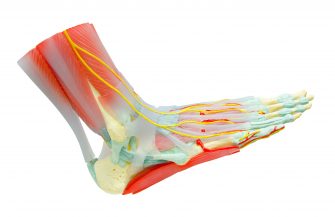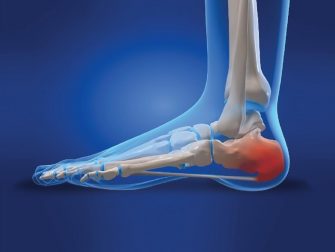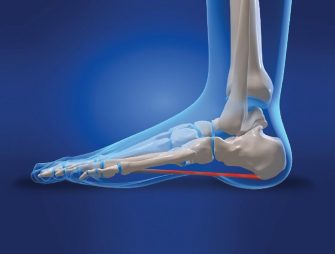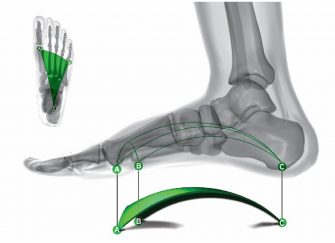Custom Molded, Flexible, Three Arch Orthotics are an Effective Solution for Plantar Fasciitis and Plantar Heel Pain
 By Kevin Wong, DC
By Kevin Wong, DC
Our feet are perhaps the most overused and under-appreciated parts of the human body. We use them relentlessly, depending on them daily to bear our body weight, transport us places and allow us to stand, walk and run. Only in cases where they are painful do we bother to have them looked at. Even then, proper and complete knowledge of the feet, their movement patterns and their effects on the rest of the body are rarely adequately taught.
In the world of foot pain, heel pain and plantar fasciitis are among the most common ailments people consult a medical provider for. Up to ten percent of the population will present with heel pain over the course of their lives, and it can affect everyone who engages in weight-bearing physical activity. (1) It is important for the healthcare consumer to understand the various treatment options available.
Aside from physiotherapy modalities (i.e., cold laser, ultrasound, etc.), stretching/strengthening exercises and braces, foot orthotics are very often prescribed. The belief is the bottom of the feet are supported by an external device to “shore up the arch”.
On March 19, 2018, an article was published by the British Journal of Sports Medicine. The article was titled Efficacy of foot orthoses for the treatment of plantar heel pain: a systematic review and meta-analysis. It reviewed “current” literature and analyzed how effective orthotics were for plantar heel pain. In conclusion, the article found that there was no difference in improvement in pain or function between prefabricated, custommade and sham orthoses in the treatment of patients with plantar heel pain.
Since the article’s release, some media outlets have released news reports discussing the article, but they have interchanged plantar heel pain with plantar fasciitis. Although the areas of involvement are close to each other, clinically speaking they are not the same and not synonymous. It is essential for patients and the public to know the difference so let’s make sure we define these terms as separate ailments.

Plantar heel pain is soreness or tenderness of the heel that has a location restricted to the underside or pad of the heel. It often radiates from the central part of the heel pad or the medial tubercle to the back of the heel itself.

Plantar Fasciitis involves inflammation or irritation of a thick band of tissue (the plantar fascia) that runs across the bottom of your foot from the heel bone to your toes. In this instance, pain is located anywhere on or radiate from the medial tubercle across the plantar fascia up to the toes. Here the plantar fascia gets excessively stretched and irritated.
Because of their location, plantar heel pain and plantar fasciitis are not the same thing. It may seem like splitting hairs, but in the study, we mentioned above, their findings made conclusions only for plantar heel pain, not plantar fasciitis.
The argument of which treatment(s) are helpful for plantar surface foot pain has been made for years by different health care providers and patients. Some believe there is no effective treatment for plantar surface foot pain while others vehemently disagree. It comes down to the patient and their specific situation. There is not a one size fits all treatment for Plantar Heel Pain and Plantar Fasciitis.
To better understand what can be done to help these conditions, let’s take a look at the anatomy of the feet. The twenty-six bones of each foot are supported on the underside by three arches:the medial, lateral, and transverse. Most people only think we have one arch.

These three arches are fully formed by age seven and together they are vital for supporting not only the feet but the ankles, knees, hips, pelvis and the entire spine above.
Now back to the British Journal of Sports Medicine Study. Recall, that the study evaluated existing research that had previously been published. The article found that there was no difference in improvement in pain or function between prefabricated, custom-made and sham orthoses in the treatment of patients with plantar heel pain.
If one analyzes the information in the study carefully, the type of orthotics that had been studied were custom made or prefabricated, hard, rigid, single arch support inserts. The orthotics in those studies were not custom molded, flexible and three arch support. There is a big difference between these types of orthotics and those classically made which are rigid.
The types of orthotics discussed in the study did not provide adequate support for all three arches of the feet. So, to be very specific, the study itself came to conclusions that are aimed explicitly at classic hard, rigid orthotic with one arch support.
When a custom molded, flexible, three arch orthotic is worn by the patient, it gives the appropriate amount of support for the feet. The three-arch support takes the stretch or elongating force caused by the over pronation or supination to the plantar fascia and reduces it significantly minimizing or eliminating the pain.
Pat McKee, a retired University of Toronto professor of occupational science and therapy, used to teach students how to make custom foot orthotics out of thermal plastics. She had this to say about custom orthotics and Plantar Fasciitis to CTV News: “Some (custom orthotics) are created better than others. I personally think it is better if they are shock absorbing and not a really hard plastic.”
Custom molded, flexible and three arch support orthotics do the following:
- Absorb 30% more ground shock with each step thereby reducing the stress on the ankle, knee, hips, pelvis and the spine.
- Provide individual support for all three arches under each foot in all weightbearing positions.
- Help enhance the nerve sensation, circulation and muscle balance in the feet.
- The reduction of stress in the joints above the feet will allow the muscles to fire in a healthier pattern, reduce nerve involvement and reduce pain.
- Help prevent injuries in the joints of the body that arise from the repetitive stress created by over-pronation and excessive supination.
Ultimately, treatment for Plantar Heel Pain and Plantar Fasciitis comes down to the patient and their specific situation. Custom orthotics can be an effective treatment for Plantar Fasciitis. The types of orthotics discussed in the study were hard, rigid orthotics with one arch support and did not provide adequate support for all three arches of the feet. Custom molded, flexible, three arch orthotics give the appropriate amount of support and take the stretch or elongating force, caused by the over pronation or supination to the plantar fascia, and reduces it significantly minimizing or eliminating the pain.
REFERENCE Charles Cole, M.D., Craig Seto, M.D., and John Gazewood, M.D., M.S.P.H., University of Virginia School of Medicine, Charlottesville, Virginia Am Fam Physician. 2005 Dec 1;72(11):2237-2242
“This article is provided courtesy of TCA Silver Corporate Member, FootLevelers, Inc.”